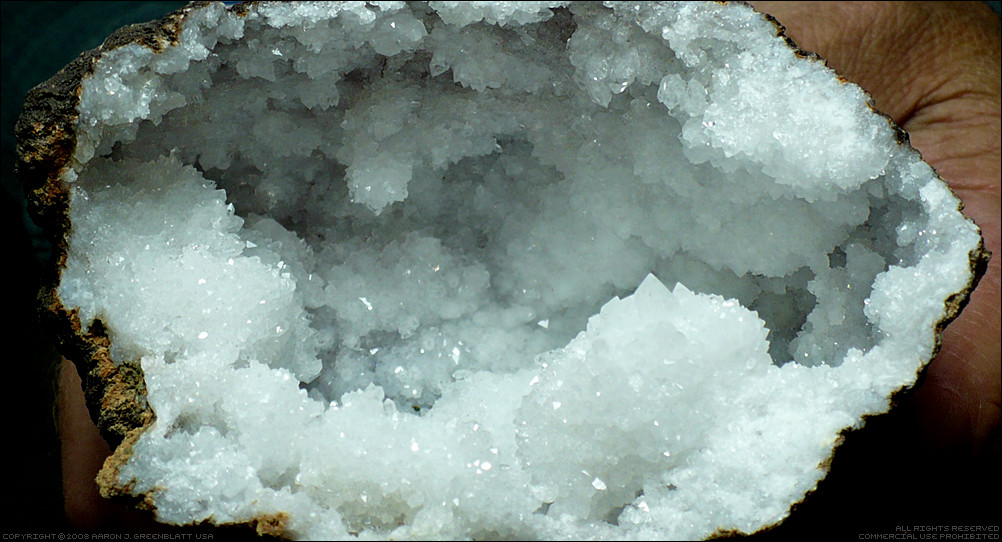HOME | DD
 Undistilled — Quartz Geode
Undistilled — Quartz Geode

Published: 2009-11-15 20:30:00 +0000 UTC; Views: 2416; Favourites: 30; Downloads: 88
Redirect to original
Description
(please click image for full view and scroll right)Title: Quartz Geode
Medium: Digital Photography
Photographer: Aaron J. Greenblatt
Camera Type: Panasonic DMC-LZ7 Lumix 7.2 MP
Editing: Edited in PhotoShop 7.0 for color accuracy, size, and to apply copyright and border.
Location: Photograph taken at the 2008 Southeastern Michigan Gem and Mineral Show at the Southgate Civic Center in Southgate, Michigan. Show hosted by the Midwest Mineralogical & Lapidary Society .
Description: This beautiful quartz geode was for sale by one of the dealers at the show. It was sitting in a glass case and the dealer offered to take it out and hold it still while I took a picture of it. The geode is 6-7 inches in length and contained some of the brightest white quartz crystals I have ever seen. In fact, the crystals were so white that I was almost sure that my camera wouldn't be able to capture them, especially in any depth. Thankfully, my macro setting and automatic light sensor compensated for the brightness.
Unfortunately, I can't remember where the dealer said that this specimen was from.
About Geodes: Geodes are geological rock formations which occur in sedimentary and certain volcanic rocks. Geodes are essentially rock cavities or vugs with internal crystal formations or concentric banding. The exterior of the most common geodes is generally limestone or a related rock, while the interior contains quartz crystals and/or chalcedony deposits. Geodes can form in any cavity, but the term is usually reserved for more or less rounded formations in igneous and sedimentary rocks, while the more general term "vug" is applied to cavities in fissures and veins.
Geode Formation: Geodes can form in gas bubbles in igneous rocks, such as vesicles in basaltic lavas, or as in the American Midwest, rounded cavities in sedimentary formations. After rock surrounding the cavity hardens, dissolved silicates and/or carbonates are deposited on the inside surface. Over time, this slow feed of minerals in groundwater or hydrothermal solutions allows crystals to form inside the hollow chamber. Bedrock containing geodes eventually weathers and decomposes, leaving them present at the surface if they are composed of resistant material such as quartz. But this is only one theory of geode formation.
Geodes are a variable phenomenon and, therefore, many theories exists to explain how they are created. Each geode is unique in composition and can only be truly discovered when cracked open or cut with a rock saw. The size and formation of crystals and different shades of color within the crystals make each geode special. The rough exterior of the geode gives no indication of what can be found within its core.
Information Sources:
[link] (wiki - Geode)
[link] (desertusa.com - Geode)
[link] (rocksandminerals4u.com - Geodes)
Legal: Copyright © Aaron J. Greenblatt. All rights reserved. Commercial use prohibited. This image and commentary may not be used for any reason without expressed written consent.
Please click here to view my photography work located in my Gallery.
Please click here for images of my glass work located in my other Gallery.
Please click here for images of my glass studio located in my other Scraps.
Related content
Comments: 5

Wow thats a white geode i have some quartz that are like that but they ar small and clear. like my Quartz cluster image.
👍: 0 ⏩: 0

Great geode! I've seen just a few times clean quartz geode- amethyst are the most popular here on mineral shows
👍: 0 ⏩: 1

Yeah, I think that this one being so white and clean on the inside is quite unusual. I've also seen only a few that were similar to it - and certainly none that were such a bright white.
👍: 0 ⏩: 0

Geodude's (Pokémon) name may be a combination of the prefix geo, earth, and dude, a slang word for a male. It may also be from geode, a usually hollow rock with crystals inside, and the word dude.
👍: 0 ⏩: 0



























